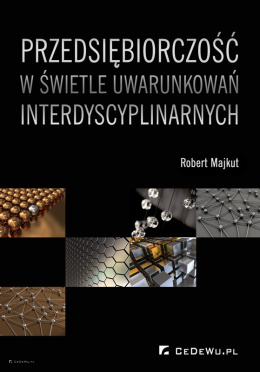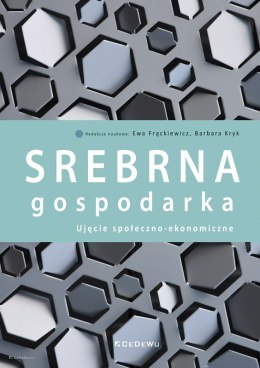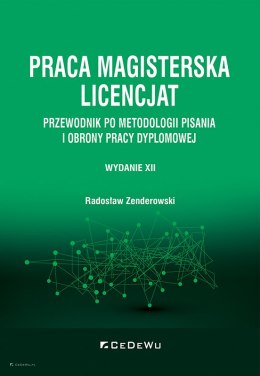- Kategorie
-
EFEKT CANTILLONA - czyli dlaczego pieniądz ma znaczenie? (wyd. II)

Książka napisana na podstawie rozprawy doktorskiej wyróżnionej w 2017 r. nagrodą Prezesa Rady Ministrów. Któż się nie zgodzi, że pieniądz ma znaczenie? Niestety, ekonomiści nie eksplorują dostatecznie kwestii związanych z inflacją monetarną i efektem Cantillona, czyli efektem dystrybucyjno-cenowym wynikającym z nierównomiernych zmian w podaży pieniądza oraz jego wpływem na gospodarkę. Wzrost podaży pieniądza nie wpływa w tej samej proporcji i w tym samym czasie na salda pieniężne wszystkich podmiotów gospodarczych - nowe pieniądze wprowadzane są do gospodarki poprzez określone kanały - dlatego też następuje dystrybucja dochodu oraz zmiany w strukturze relatywnych cen i produkcji. Niniejsza książka stanowi pierwsze systematyczne badanie kreacji nowych pieniędzy i kredytu w duchu pionierskiej analizy R. Cantillona. Autor pokazuje, że dla gospodarki istotny nie jest wyłącznie sam wzrost podaży pieniądza, ale także sposób, w jaki on zachodzi. Publikacja stanowi zatem ważny głos w fundamentalnej debacie na temat roli czynników pieniężnych w gospodarce, jak również na temat efektów i zasadności luźnej polityki monetarnej. Autor wykazał nie tylko olbrzymią erudycję w zakresie badanej problematyki, ale również fascynację przedmiotem badań. Niewątpliwym walorem pracy jest jej kompleksowość, polegająca na interpretacji analizowanych zjawisk z różnych punktów widzenia (...). Prof. dr hab. Stanisław Rudolf Za wartościowy (...) wkład Autora do nauk ekonomicznych przychodzi uznać Jego rozważania o współczesnych zjawiskach stanowiących następstwo nierównomiernego rozprzestrzeniania się wzrostu podaży pieniądza w gospodarce (bańki cenowe, zróżnicowane postaci cykli koniunkturalnych, powiększanie się nierówności dochodowo-majątkowych w dzisiejszych społeczeństwach, występowanie międzynarodowych efektów wzrostu podaży pieniądza). Fragmenty pracy odnoszące się do powyższych kwestii są cennym wkładem do aktualnej dyskusji o stanie gospodarki światowej - w tym do oceny polityki pieniężnej prowadzonej przez największe banki centralne świata. Prof. dr hab. Dariusz Filar
| Kod kreskowy | |
| ISBN | 978-83-8102-582-9 |
| EAN | 9788381025829 |
Któż się nie zgodzi, że pieniądz ma znaczenie? Niestety, ekonomiści nie eksplorują dostatecznie kwestii związanych z inflacją monetarną i efektem Cantillona, czyli efektem dystrybucyjno-cenowym wynikającym z nierównomiernych zmian w podaży pieniądza oraz jego wpływem na gospodarkę. Wzrost podaży pieniądza nie wpływa w tej samej proporcji i w tym samym czasie na salda pieniężne wszystkich podmiotów gospodarczych - nowe pieniądze wprowadzane są do gospodarki poprzez określone kanały - dlatego też następuje dystrybucja dochodu oraz zmiany w strukturze relatywnych cen i produkcji. Niniejsza książka stanowi pierwsze systematyczne badanie kreacji nowych pieniędzy i kredytu w duchu pionierskiej analizy R. Cantillona. Autor pokazuje, że dla gospodarki istotny nie jest wyłącznie sam wzrost podaży pieniądza, ale także sposób, w jaki on zachodzi. Publikacja stanowi zatem ważny głos w fundamentalnej debacie na temat roli czynników pieniężnych w gospodarce, jak również na temat efektów i zasadności luźnej polityki monetarnej.
Autor wykazał nie tylko olbrzymią erudycję w zakresie badanej problematyki, ale również fascynację przedmiotem badań. Niewątpliwym walorem pracy jest jej kompleksowość, polegająca na interpretacji analizowanych zjawisk z różnych punktów widzenia (...).
Prof. dr hab. Stanisław Rudolf
Za wartościowy (...) wkład Autora do nauk ekonomicznych przychodzi uznać Jego rozważania o współczesnych zjawiskach stanowiących następstwo nierównomiernego rozprzestrzeniania się wzrostu podaży pieniądza w gospodarce (bańki cenowe, zróżnicowane postaci cykli koniunkturalnych, powiększanie się nierówności dochodowo-majątkowych w dzisiejszych społeczeństwach, występowanie międzynarodowych efektów wzrostu podaży pieniądza). Fragmenty pracy odnoszące się do powyższych kwestii są cennym wkładem do aktualnej dyskusji o stanie gospodarki światowej - w tym do oceny polityki pieniężnej prowadzonej przez największe banki centralne świata.
Prof. dr hab. Dariusz Filar
Wstęp 9
Rozdział 1
Neutralność pieniądza 13
1.1. Neutralność instytucjonalna 14
1.2. Neutralność statyczna 15
1.3. Neutralność dynamiczna 16
1.4. Superneutralność 22
1.5. Neutralność monetarna 22
Rozdział 2
Teoria efektu Cantillona 25
2.1. Efekt Cantillona a inflacja monetarna oraz nieneutralność pieniądza 26
2.2. Istota efektu Cantillona 29
2.3. Efekt Cantillona a cykl koniunkturalny 37
Rozdział 3
Efekt Cantillona w historii myśli ekonomicznej 43
3.1. Richard Cantillon 43
3.2. David Hume 47
3.3. John Cairnes 48
3.4. Pozostali ekonomiści klasyczni 49
3.5. Irving Fisher 50
3.6. John Maynard Keynes, nowi keynesiści oraz postkeynesiści 51
3.6.1. Nowa szkoła keynesowska 52
3.6.2. Szkoła postkeynesowska 53
3.7. Milton Friedman 54
3.8. Nowa szkoła klasyczna 58
3.9. Szkoła austriacka 59
3.10. Pozostałe szkoły i kierunki 64
3.10.1. Szkoła realnego cyklu koniunkturalnego 64
3.10.2. Teoria nierównowagi monetarnej 65
3.10.3. Ekonomia mechanizmu transmisji monetarnej 65
3.10.4. Ekonomia polityki monetarnej i segmentacji rynku 66
3.10.5. Teoria chaosu 67
Rozdział 4
Klasyfikacja efektu Cantillona 71
4.1. Rynkowe kanały wzrostu podaży pieniądza 74
4.1.1. Prywatna produkcja pieniądza towarowego 75
4.1.2. Wydatki turystów zagranicznych 76
4.1.3. Imigracja i transfer majątku (spieniężonego) 77
4.1.4. Prywatne, jednostronne transfery zagraniczne 77
4.1.5. Eksport dóbr 78
4.1.6. Inwestycje zagraniczne 78
4.2. Nierynkowe kanały wzrostu podaży pieniądza 80
4.2.1. Grabież 80
4.2.2. Nierynkowa pomoc zagraniczna 81
4.2.3. Zagraniczny dług publiczny 82
4.2.4. Psucie monety 83
4.2.5. Państwowy druk pieniądza 85
4.2.6. Ekspansja kredytowa 86
Rozdział 5
Efekt Cantillona a ekspansja kredytowa 93
5.1. Na czym polega ekspansja kredytowa? 93
5.2. Na czym polega efekt Cantillona w procesie ekspansji kredytowej? 96
Rozdział 6
Efekt Cantillona a wtórne cechy cyklu koniunkturalnego 101
6.1. Efekt Cantillona a rożne sposoby kreacji depozytów 102
6.2. Efekt Cantillona a rożne rodzaje kredytów 106
6.3. Dane empiryczne dotyczące różnic w polityce inwestycyjnej banków komercyjnych 110
Rozdział 7
Efekt Cantillona a bańki cenowe 121
7.1. Kanały oddziaływania wzrostu podaży pieniądza na ceny aktywów 122
7.2. Efekt Cantillona wynikający z inflacji monetarnej zachodzącej poprzez rynek aktywów 127
Rozdział 8
Efekt Cantillona a nierówności dochodowo-majątkowe 131
8.1. Kanały oddziaływania efektu Cantillona na nierówności dochodowo-majątkowe 134
8.2. Dane empiryczne dotyczące kształtowania się nierówności dochodowo-majątkowych w Stanach Zjednoczonych 138
Rozdział 9
Międzynarodowy efekt Cantillona 143
9.1. Międzynarodowy efekt Cantillona w rożnych systemach monetarnych 143
9.2. Międzynarodowe skutki ekspansji kredytowej 145
Streszczenie oraz wnioski końcowe 155
Aneks
O tym jak Richard Cantillon dorobił się fortuny, stworzył teorię ekonomii i umarł w niewyjaśnionych okolicznościach 163
Bibliografia 171
Wykaz tabel 187
Wykaz rysunków 189
Arkadiusz Sieroń uzyskał tytuł doktora nauk ekonomicznych w 2016 roku; obecnie pracuje jako adiunkt na Uniwersytecie Wrocławskim. Jest członkiem zarządu Instytutu Edukacji Ekonomicznej im. Ludwiga von Misesa oraz autorem killkudziesięciu publikacji naukowych (m.in. w „Quarterly Journal of Austrian Economics", „Prague Economic Papers"). Stypendysta amerykańskiego The Ludwig von Mises Institute oraz zdobywca III miejsca w The 6th International VERNON SMITH PRIZE for the Advancement of Austrian Economics.
Recenzenci:
Prof. dr hab. Stanisław Rudolf
Dr hab. Dariusz Filar, prof. UG
Abel A.B., Bernanke B.S., 2011, Macroeconomics, Boston, Mass.: Addison Wesley Longman.
Acemoglu D., 2000, Technical Change, Inequality, and the Labor Market, NBER Working Paper, nr 7800, czerwiec.
Adalid R., Detken C., 2007, Liquidity Shocks and Asset Price Boom/Bust Cycles, European Central Bank Working Paper Series, nr 732, luty.
Adam K., Tzamourani P., 2015, Distributional consequences of asset price inflation in the price inflation in the euro area, Deutsche Bank Discussion Paper, nr 27, nr 1-17.
Adams R.H. Jr., 1991, The Effects of International Remittances on Poverty, Inequality and Development in Rural Egypt, International Food Policy Research Institute Research Report, nr 96.
Alvarez F., Atkeson A., Kehoe P.J., 2000, Money, Interest Rates, And Exchange Rates With Endogenously Segmentet Asset Markets, NBER Working Paper Series, Working Paper nr 7871.
Antolin P., Schich S., Yermo J, 2011, The Economic Impact of Protracted Low Interest Rates on Pension Funds and Insurance Companies, OECD Journal: Financial Market Trends, vol. 2011, nr 1.
Anthonisen N., 2007, Monetary Shocks in a Spatial Overlapping Generations Model, 2008 Meetings Papers, Society for Economic Dynamics, nr 455, wrzesień.
Ardahaey F.T., 2011, Economic Impacts of Tourism Industry, International Journal of Business and Management, vol. 6, nr 8.
Aschheim J., Hsieh C-Y., 1969, Macroeconomics, Income and Monetary Theory, Charles E. Merrill, Columbus, Ohio.
Aschheim J., 1973, Neutral money reconsidered, Banca Nazionale del Lavoro Quarterly Review, 105.
Avdjiev S., McCauley R., McGuire P., 2012, Rapid credit growth and international credit: Challenges for Asia, BIS Working Papers, nr 377, kwiecień.
Baeriswyl R., Cornand C., 2015, The distortionary effect of monetary policy: credit expansion vs. lump-sum transfers in the lab, GATE Working Paper, nr 1516.
Bagus P., 2007, Asset Prices – An Austrian Perpective, Procesos de Mercado: Revista Europea de Economía Política, vol. 4, nr 2.
Bagus P., 2011, Tragedia euro, Instytut Ludwiga von Misesa, Warszawa.
Baker D., 2008, The housing bubble and the financial crisis, Real-World Economics Review, nr 46, Center for Economic and Policy Research.
Balac Z., 2008, Monetary Inflation’s Effect on Wealth Inequality: An Austrian Analysis, Quarterly Journal of Austrian Economics, vol. 11, nr 1.
Bank of England, 2012, The distributional effects of asset purchases, Quarterly Bulletin, vol. 52, nr 3.
Barro R., 1976, Rational Expectations and the Role of Monetary Policy, Journal of Monetary Economics, nr 2.
Barro R., 1977, Long-Term Contracting, Sticky Prices, And Monetary Policy, Journal of Monetary Economics, nr 3.
Bastiat F., [1848] 2003, Co widać i czego nie widać, tłum. Piotr Stachura, Lublin-Rzeszów: Instytut Liberalno-Konserwatywny, Wydawnictwo Dextra.
Bauer P., Yamey B., 1983, Foreign aid: what is at stake, The Third World, ed. W. Scott Thompson. San Francisco: Institute for Contemporary Studies.
Beck T., Büyükkarabacak B., Rioja F.K., Valev N.T., 2012, Who Gets Credit? And Does it Matter? Household vs. Firm Lending Across Countries, The B.E. Journal of Macroeconomics, vol. 12, nr 1.
Becker J.G., 1934, Banks and Real Estate Loans, [w:] Willis H.P., Chapman J.M. (red.), The Banking Situation: America Post-War Problems and Developments, Morningside Heights, N.Y.: Columbia University Press.
Becker C., 2013, Africa: The Next Major Boom-Bust Cycle?, 22.08.2013 r., https://mises.org/daily/6511/Africa-The-Next-Major-BoomBust-Cycle (dostęp: 18.07.2014 r.).
Beenstock M., Fisher J., 1997, The Macroeconomic Effects of Immigration: Israel in the 1990s, Weltwirtschaftliches Archiv, vol. 133, nr 2.
Belke A., Orth W., Setzer R., 2008, Liquidity and the dynamic pattern of price adjustement: a global view, Discussion Paper Series 1: Economic Studies, Deutsche Bundesbank, nr 25/2008.
Benedyk M., 2012, Austriacka teoria cyklu koniunkturalnego a teorie głównego nurtu, http://mises.pl/blog/2012/02/18/benedyk-austriacka-teoria-cyklu-koniunkturalnego-a-teorie-glownego-nurtu/ (dostęp: 25.02.2013 r.).
Berends K., McMenamin R., Plestis T., Roses R.J., 2013, The sensitivity of life insurance firms to interest rate changes, Federal Reserve Bank of Chicago Economic Perspectives, nr 2Q/2013.
Bernanke B.S., 2002, Deflation: Making Sure „It” Doesn’t Happen Here, Speech before the National Economists Club, Washington, D.C., 21.11.2002 r., http://www.federalreserve.gov/boarddocs/Speeches/2002/20021121/default.htm (dostęp: 7.01.2016 r.).
Bernanke B.S., 2007, The Level and Distribution of Economic Well-Being, Speech before the Greater Omaha Chamber of Commerce, Omaha, Nebraska, 6.02.2015 r.
Bilo S., 2013a, The International Business Cycle as a Coordination Failure, Department of Economics, George Mason University.
Bilo S., 2013b, Back to Cantillon: On the Relevance of the Monetary Economics of Richard Cantillona, rozprawa doktorska, George Mason University.
Bilo S., 2015, How Cantillon and Hume Propose the Same Theory of First-Round Effects, CHOPE Working Paper, nr 2015-02, maj.
BIS, 2015, 85th Annual Report, Basel: BIS.
Blake A., 2008, Tourism and Income Distribution in East Africa, International Journal of Tourism Research, nr 10, 2008.
Blaug M., 1994, Teoria ekonomii: ujęcie retrospektywne, tłum. I. Budzyńska et al. PWN, Warszawa.
Blaug M., 2000, Teoria ekonomii: ujęcie retrospektywne, tłum. I. Budzyńska et al., wyd. 2, PWN, Warszawa.
Block W., Barnett W., Salerno J., 2006, The relationship between wealth or income and time preference is empirical, not apodictic: a critique of Rothbard and Hoppe, „Review of Austrian Economics”, vol. 19, nr 1, s. 69-80.
Bolton A.H., 1963, Introduction to bank credit analysis, Tremblay (Bermuda): Bolton.
Bond M.E., Landman J.R., 1972, Tourism: A Strategy for Development, Nebraska Journal of Economics and Business, vol. 11, nr 1.
Board of Governors of the Federal Reserve System, 2015, Assets and Liabilities of Commercial Banks in the United States (Weekly) – H.8, March 27, 2015, http://www.federalreserve.gov/releases/H8/current/ (dostęp: 3.04.2015 r.).
Bordo M.D., 1986, Money, Deflation and Seigniorage in the Fifteenth Century. A Review Essay, Journal of Monetary Economics, vol. 18, nr 3.
Bordo M.D., 1993,The Bretton Woods International Monetary System: A Historical Overview, [w]: Bordo M.D., Eichengreen B. (red.), A Retrospective on the Bretton Woods System: Lessons for International Monetary Reform, Chicago: University of Chicago Press.
Bordo M.D., Helbling T.F., 2010,International Business Cycle Synchronization in Historical Perspective, NBER Working Paper Series, nr 16103, czerwiec.
Bordo M.D., Landon-Lane J., 2013, Does Expansionary Monetary Policy Cause Asset Price Booms; Some Historical and Empirical Evidence, NBER Working Paper Series, nr 19585.
Borio C., Kennedy N., Prowse S.D., 1994, Exploring Aggregate Asset Price Fluctuations Across Countries. Measurement, determinants and monetary policy implications, BIS Economic Papers, nr 40, kwiecień.
Borio C., Lowe P., 2002, Asset prices, financial and monetary stability: exploring the nexus, BIS Working Papers, nr 114.
Borio C., Filardo A., 2007, Globalisation and inflation: New cross-country evidence on the global determinants of domestic inflation, BIS Working Papers, nr 227.
Borio C., Disyatat P., 2011, Global imbalances and the financial crisis: Link or no link? BIS Working Paper, nr 346, maj.
Borio C., 2012, The financial cycles and macroeconomics: What have we learn? BIS Working Papers, nr 395.
Borio C. James H., Shin H.S., 2014, The international monetary and financial system: a capital account historical perspective, BIS Working Papers, nr 457, sierpień.
Bowdler Ch., Radia A., 2012, Unconventional monetary policy: the assessment, Oxford Review of Economic Policy, vol. 28, nr 4.
Bresciani-Turroni C., 2007, The Economics of Inflation: A Study of Currency Depreciation in Post-War Germany, Auburn, Ala.
Brown Ch., Thornton M., 2016, Jak teoria przedsiębiorczości stworzyła ekonomię, tłum. J. Tarasiuk, mises.pl, http://mises.pl/wp-content/uploads/2016/04/Brown-Thornton_Jak-teoria-przedsi%C4%99biorczo%C5%9Bci-stworzy%C5%82a-ekonomi%C4%99.pdf (dostęp: 30.05.2017 r.).
Brunner K., Meltzer A.H., 1988, Money and Credit in the Monetary Transmission Process, The American Economic Review, vol. 78, nr 2.
Bruno V., Shin H.S., 2014, Cross-border banking and global liquidity, BIS Working Papers, nr 458, sierpień.
Brunnermeier M., Sannikov Y., 2012, Redistributive Monetary Policy, Proceedings – Economic Policy Symposium – Jackson Hole, Federal Reserve Bank of Kansas City.
Brzoza-Brzezina M., Kłos B., Kot A., Łyziak T., 2002, Hipoteza neutralności pieniądza, Materiały i Studia, NBP, Warszawa.
Buchanan J.M., Wagner R.E., 1967, Public Debt in a Democratic Society, Washington, D.C.: American Enterprise Institute for Public Policy Research.
Buchsbaum B.D., 2004, Ecotourism and Sustainable Development in Costa Rica, Major Paper Submitted to Virginia Polytechnic Institute and State University, Master of Public and International Affairs College of Architecture and Urban Studies.
Buhr, C-C, 1999, The French War Reparations and the German Post-War Boom 1871-1873, FernUniversität in Hagen Working Paper Series.
Burtless G., 1999, Effects of Growing Wage Disparities and Changing Family Composition on the U.S. Income Distribution, Center on Social and Economic Dynamics Working Paper, nr 4, lipiec.
Butler A., 1990, A Methodological Approach to Chaos: Are Economists Missing the Point? Federal Reserve Bank of St. Louis Review, vol. 72, nr 2.
Butos W., 1986, Hayek and general equilibrium analysis, Southern Economic Journal, vol. 52, nr 2.
Cachanosky N., 2012, The Mises-Hayek Business Cycle Theory, Fiat Currencies and Open Economies, Department of Economics, Suffolk University.
Cagan P., 1969, The Non-Neutrality of Money In the Long Run: A Discussion of the Critical Assumptions and Some Evidence, Journal of Money, Credit and Banking, vol. 1, nr 2.
Cagetti M., De Nardi M., 2003, Entrepreneurship, Frictions and Wealth, Journal of Political Economy, vol. 114, nr 5.
Cairnes J.E., 1873, Essays in Political Economy Theoretical and Applied, London: Macmillan and Co.
Cairnes J.E., 1878, Some Leading Principles of Political Economy Newly Expounded, Harper & Brothers Publishers, New York.
Callahan G., Garrison R., 2003, Does Austrian Business Cycle Theory Help Explain The Dot-Com Boom and Bust, The Quarterly Journal of Austrian Economics, vol. 6, nr 2, lato.
Canova F., Ciccarelli M., Ortega E., 2004, Similarities and Convergance in G-7 Cycles, European Central Bank Working Paper Series, nr 312, luty.
Cantillon R., 1755 [1938], Ogólne rozważania nad naturalnymi prawami handlu, tłum. W. Zawadzki, Warszawa: Szkoła Główna Handlowa w Warszawie.
Caplin A.S., Spulber D.F., 1987, Menu Costs and the Neutrality of Money, The Quarterly Journal of Economics, vol. 102, nr 4.
Carroll Ch.D., Otsuka M., Slacalek J., 2006, How Large is the Housing Wealth Effect? A New Approach, NBER Working Paper Series, nr 12746.
Carpenter S.B., Demiralp S., 2010, Money, Reserves, and the Transmission of Monetary Policy: Does the Money Multiplier Exists? The Federal Reserve Board Finance and Economics Discussion Series, nr 2010-41.
Castaldo A., Reilly B., 2007, Do Migrant Remittances Affect the Consumption Patterns of Albanian Households? South-Eastern Europe Journal of Economics, vol. 5, nr 1.
Cecchetti S.G., Genburg H., Lipski J., Wadhwani S., 2000, Asset Prices and Central Bank Policy, Geneva Reports on the World Economy, International Center for Monetary and Banking Studies and Centre for Economic Policy Research, London.
Cetorelli N., Goldberg L.S., 2009, Globalized Banks: Lending to Emerging Markets in the Crisis, Federal Reserve Bank of New YorkStaff Report, nr 377, czerwiec.
Cheng W., Angus S.D., 2012, The Cantillon Effect of Money Injection through Deficit Spending, Monash University Department of Economics Discussion Paper, 12/12.
Ciccarelli M., Mojon B., 2005, Global Inflation, ECB Working Paper Series, nr 536, październik.
Claessens, S., Pozsar, Z., Ratnovsk, L., Singh M., 2012, Shadow Banking: Economics and Policy, IMF Staff Discussion Note, nr SDN/12/12.
Claeys G., Darvas Z., Leandro Á., Walsh T., 2015, The Effects of Ultra-Loose Monetary Policies on Inequality, Policy Contribution, Bruegel, nr 9, czerwiec 2015.
Cochran J.P., 2010, Capital in Disequilibrium: Understanding the ‘Great Recession’ and the Potential for Recovery, The Quarterly Journal of Austrian Economics, vol. 13, nr 3, jesień.
Cœuré B. 2012, What can monetary policy do about inequality, Speech at the International Day for the Eradication of Poverty, Intergroup „Extreme Poverty and Human Rights, Fourth World Committee”, Brussels, 17.10.2012.
Coibion, O., Gorodnichenko, Y., Kueng, L., Silvia J., 2012, Innocent Bystanders? Monetary Policy and Inequality in the U.S., IMF Working Paper, nr WP/12/199, sierpień.
Cottrel A., 1994, Post Keynesian Monetary Economics: A Critical Survey, Cambridge Journal of Economics, vol. 18, nr 6.
Cowen T., Kroszner R., 1987, The Development of the New Monetary Economics, Journal of Political Economy, vol. 95, nr 3.
Daley S., Wagner R., 2004, Money and the Real Economy: A Computational Search for Cantillon Effects, Mercatus Center at George Mason University Working Paper, nr 46.
Davenport H.J., 1913, The Economics of Enterprise, New York: The Macmillan Company.
Davidson L., 2013, Krytyka teorii nierównowagi monetarnej i systemu rezerwy cząstkowej, tłum. M. Szadowiak, 13.03.2013 r., http://mises.pl/blog/2013/03/13/davidson-krytyka-teorii-nierownowagi-monetarnej-i-systemu-rezerwy-czastkowej/ (dostęp: 6.01.2016 r.).
Detken C., Smets F., 2004, Asset Price Booms and Monetary Policy, ECB Working Paper Series, nr 364, maj.
Devereux M.B., Smith G.W., 2005, Transfer Problem Dynamics: Macroeconomics of the Franco-Prussian War Indemnity, Journal of Monetary Economics, vol. 54, nr 8.
Disyatat P., 2008, Monetary policy implementation: Misconceptions and their consequences, BIS Working Paper, nr 269.
Dobbs R., Lund S., Koller S., Shwayder A., 2013, QE and ultra-low interest rates: Distributional effects and risks, The McKinsey Global Institute Discussion Paper, listopad.
Doepke M., Schneider M., 2005, Real Effects of Inflation Through the Redistribution of Nominal Wealth, Federal Reserve Bank of Minneapolis Research Department Staff Report, nr 355, luty.
Dorobăţ C.E., 2015, Cantillon Effects in International Trade. The Consequences of Fiat Money for Trade, Finance and the International Distribution of Wealth, rozprawa doktorska, 18.06.2015 r., Université d’Angers.
Easterly W., Fischer, S., 2001, Inflation and the Poor, Journal of Money, Credit and Banking, vol. 33 nr 2, część 1.
Eichengreen B., 1989, The U.S. Capital Market and Foreign Lending, 1920-1955, [w]: Sachs J.D. (ed.), Developing Country Debt and Economic Performance, Volume 1: The International Financial System, Chicago: University of Chicago Press.
Eichner M.J., Kohn D.L., Palumbo M.G., 2010, Financial Statistics for the United States and the Crisis: What Did They Get Right, What Did They Miss, and How Should They Change? The Federal Reserve Board Finance and Economics Discussion Series, kwiecień.
Engelhardt L.M., 2004, Business Cycles in an International Context, Ludwig von Mises Institute Working Paper, 7.07.2004 r.
Erosa A., Ventura G., 2002, On Inflation as a Regressive Tax, Journal of Monetary Economics, vol. 49, nr 4.
Estey J.A., 1950, Business Cycles, wyd. 2, New York: Prentice-Hall.
Fabozzi, F.J., 2000, Bond Markets, Analysis and Strategies, 4th ed. New York: Prentice Hall.
Federal Reserve Bank of Chicago, 1994, Modern Money Mechanics: A Workbook on Bank Reserves and Deposit Expansion, Chicago: Federal Reserve Bank of Chicago.
Federal Reserve Bank of St. Louis, 2015a, St. Louis Adjusted Monetary Base, 15.08.2015 r., http://research.stlouisfed.org/fred2/series/AMBSL# (dostęp: 27.08.2015 r.).
Federal Reserve Bank of St. Louis, 2015b, Income Gini Ratio for Households by Race of Householders, All Races, 21.10.2015 r., https://research.stlouisfed.org/fred2/series/GINIALLRH (dostęp: 5.05.2016 r.).
Fengyun L., 2013, The Dynamic Effects of Money Supply on Real Estate Prices in the Japanese Pre-bubble and Bubble Period: Compared with Recent China, The Ritumeikan Economic Review, vol. 62, nr 4.
Ferreira F., Gyourko J., Tracy J., 2012, Housing busts and household mobility: an update, Economic Policy Review, Federal Reserve Bank of New York, listopad.
Fillieule R., 2007, A Formal Model in Hayekian Macroeconomics: The Proportional Goods-in-Process Structure of Production, Quarterly Journal of Austrian Economics, vol. 10, nr 3.
Fischer S., 1977, Long Term Contracts, Rational Expectations, and the Optimal Money Supply Rule, The Journal of Political Economy, vol. 85, nr 1.
Fischer, S., Modigliani, F., 1978, Towards an Understanding of the Real Effects and Costs of Inflation, NBER Working Paper Series, nr 303.
Fischer S., 1981, Relative Shocks, Relative Price Variability, and Inflation, Brookings Papers on Economic Activity, nr 2.
Fisher I., 1907, The Rate of Interest. Its Nature, Determination and Relation to Economic Phe-nomena, Macmillan, New York.
Fisher I., 1922, The Purchasing Power of Money, its Determination and Relation to Credit, Interest and Crises, Macmillan, New York.
Fisher I., 1933, The Debt-Deflation Theory of Great Depressions, Econometrica, vol. 1, nr 4.
Fleming M.J., Klagge N.J., 2010, The Federal Reserve’s Foreign Exchange Swap Lines, Current Issues in Economics and Finance, Federal Reserve Bank of New York, vol. 16, nr 4, kwiecień.
Frankel J., 2006, The Effect of Monetary Policy on Real Commodity Prices, [w:] Campbell J. (red.), Asset Prices and Monetary Policy, Chicago: University of Chicago Press, 2006.
Frankel J., 2008, Getting Carried Away: How the Carry Trade and Its Potential Unwinding Can Explain Movements in International Financial Markets, Milken Institute Review, nr 10, styczeń.
Fraser H.F., 1933, Great Britain and the Gold Standard, London: Macmillan & Company.
Friedman M., 1958, Foreign Economic Aid: Means and Objectives, The Yale Review, vol. 47, nr 4.
Friedman M., 1969a, The Optimum Quantity of Money, [w:] idem, The Optimum Quantity of Money, Chicago: Aldine Publishing Company.
Friedman M., 1969b,The Quantity Theory of Money: A Restatement, [w:] ibidem, The Optimum Quantity of Money, Chicago: Aldine Publishing Company.
Friedman M., 1969c, Post-War Trends in Monetary Theory and Policy, [w:] ibidem, The Optimum Quantity of Money, Chicago: Aldine Publishing Company.
Friedman M., 1969d, The Role of Monetary Policy, [w:] ibidem, The Optimum Quantity of Money, Chicago: Aldine Publishing Company.
Friedman M., 1969e, The Demand for Money, [w:] ibidem, The Optimum Quantity of Money, Chicago: Aldine Publishing Company.
Friedman M., 1969f, Money and Business Cycle, [w:] ibidem, The Optimum Quantity of Money, Chicago: Aldine Publishing Company.
Friedman M., 1969g, The Lag in Effect of Monetary Policy, [w:] ibidem, The Optimum Quantity of Money, Chicago: Aldine Publishing Company.
Friedman M., 1969h, Monetary Studies of the National Bureau, [w:] ibidem, The Optimum Quantity of Money, Chicago: Aldine Publishing Company.
Fuerst T.S., 1990, Liquidity, Loanable Funds, and Real Activity, J.L. Kellogg Graduate School of Management Northwestern University Discussion Paper, nr 900.
Galli R., Hoeven R., 2001, Is inflation bad for income inequality: The importance of the initial rate of inflation, ILO Employment Paper, nr 29.
Gambacorta L., 2009, Monetary policy and the risk-taking channel, BIS Quarterly Review, grudzień.
Garrison R.W., 2001, Time and Money: Macroeconomics of Capital Structure, London: Routledge.
Genay H., 2014, What is the impact of a low interest rate environment on bank profitability? Chicago Fed Letter, The Federal Reserve Bank of Chicago, lipiec 2014, nr 324.
Gereffi G., Fernandez-Stark K., 2011, Global Value Chain Analysis: A Primer, Center on Globalization, Governance and Competitiveness, Duke University, Durham, N.C., 31.05.2011 r.
Gilbert D.W., 1933, The Economic Effects of Gold Discoveries Upon South Africa: 1886-1910, The Quarterly Journal of Economics, vol. 47, nr 4.
Goldfajn I., Valdés R.O., 1997, Capital Flows and the Twin Crises: The Role of Liquidity, IMF Working Paper, nr WP/97/87, lipiec.
Gordon R.J., Hall R.E., Parkin M., 1977,World Inflation and Monetary Accommodation in Eight Countries, Brookings Papers on Economic Activity, vol. 1977, nr 2.
Gordon R.J., 1981, Output fluctuations and gradual price adjustments, NBER Working Paper Series, nr 621.
Gordon R.J., Dew-Becker I., 2005, Where Did the Productivity Growth Go? Inflation Dynamics and the Distribution of Income, NBER Working Paper Series, nr 11842.
Goryszewski R., 2011, Wokół poglądów na rolę pieniądza w gospodarce w historii i teorii ekonomii, http://www.wbs.lcs.net.pl/pliki/Goryszewski5.pdf (dostęp: 26.02.2013).
Graham F.D., 1930, Exchange, Prices, and Production in Hyper-Inflation: Germany, 1920-1923, New York: Russell & Russell.
Greenspan A., 1997, Testimony to the House Banking Committee, sesja pytań i odpowiedzi, 5.03.1997 r.
Greenspan A., 1998, Income Inequality: Issues and Policy Options, Remarks at a symposium sponsored by the Federal Reserve Bank of Kansas City, Jackson Hole, Wyoming, 28.08.1998 r.
Greenwood R., Scharfstein D., 2012, The Growth of Modern Finance, http://ssrn.com/abstract=2162179 (dostęp: 4.05.2015 r.).
Gregorio J., Lee J-W., 2002, Education and Income Inequality: New Evidence From Cross-Country Data, Review of Income and Wealth, vol. 48, nr 3, wrzesień.
Grossman S., Weiss L., 1983, A Transactions-Based Model of the Monetary Transmission Mechanism, The American Economic Review, vol. 73, nr 5.
Haas R., Lelyveld I., 2011, Multinational Banks and the Global Financial Crisis. Weathering the Perfect Storm? DNB Working Paper, nr 322, listopad.
Hagemann H., Trautwein H.M., 1998, Cantillon and Ricardo effects: Hayek’s contributions to business cycle theory, The European Journal of the History of Economic Thought, vol. 5, nr 2.
Hagemann R.P., 1982, The Variability of Inflation Rates across Households Types, Journal of Money, Credit and Banking, vol. 14, nr 4, part 1.
Hamilton E.J., 1936, Prices and Wages at Paris under John Law’s System, The Quarterly Journal of Economics, vol. 51, nr 1.
Harkness J., 1978, The Neutrality of Money in Neoclassical Growth Models, The Canadian Journal of Economics, vol. 11, nr 4.
Hayek F.A., [1933] 2014a, Teoria monetarna i cykl koniunkturalny, [w:] ibidem, Pieniądz i kryzysy. Dzieła wybrane, tom 1, tłum. M. Zieliński, Warszawa: Instytut Ludwiga von Misesa.
Hayek F.A., [1935] 2014b, Ceny i produkcja, [w:] ibidem, Pieniądz i kryzysy. Dzieła wybrane, tom 1, tłum. M. Zieliński, Warszawa: Instytut Ludwiga von Misesa.
Hayek F.A., [1937] 2014c, Nacjonalizm monetarny i stabilność międzynarodowa, [w:] Pieniądz i kryzysy. Dzieła wybrane, tom 1, tłum. Marcin Zieliński, Warszawa: Instytut Ludwiga von Misesa.
Hayek F.A., 1984, On „Neutral Money”, [w:] ibidem, Money, Capital and Fluctuations: Early Essays, Chicago: The University of Chicago Press.
Hayek F.A., 1990, Denationalisation of money – The Argument Refined. An Analysis of the Theory and Practice of Concurrent Currencies, The Institute of Economic Affairs, London.
Hayek F.A., 1991, Richard Cantillon (c. 1680-1734), [w:], ibidem, The Trend of Economic Thinking. Essays on Political Economists and Economic History, [w:] Bartley W.W. III, Kresge S. (eds.), The Collected Works of F. A. Hayek, vol. III, London: Routledge.
Heffernan S., 2007, Nowoczesna bankowość, tłum. J. Horowska, Warszawa: PWN.
Hercovitz Z., 1980, Money and the Dispersion of Relative Prices, „NBER Working Series”, nr 431.
Hoffmann A., 2009, An Overinvestment Cycle in Central and Eastern Europe, MPRA Paper, nr 15668.
Hoffmann A., Schnabl G., 2013,Monetary Nationalism and International Economic Instability, The Quarterly Journal of Austrian Economics, vol. 16, nr 2.
Hollenbeck F., 2014, How Central Banks Cause Income Inequality, 1.02.2014 r., http://mises.org/daily/6653/How-Central-Banks-Cause-Income-Inequality (dostęp: 27.08.2015 r.).
Hoppe H-H., 1994, How is Fiat Money Possible? – or, The Devolution of Money and Credit, The Review ofAustrian Economics, vol. 7, nr 2.
Hoppe H-H., 1995, The Political Economy of Monarchy and Democracy, and the Idea of a Natural Order, Journal of Libertarian Studies, vol. 11, nr 2.
Hoppe H.H., 2001, Democracy, The God That Failed: The Economics and Politics of Monar-chy, Democracy, and Natural Order, New Brunswick, N.J.
Horwitz S., 1994, Inflation, [in:] The Elgar Companion to Austrian Economics, P. Boettke (ed.), Edwar Elgar Pub., Aldershot.
Horwitz S., 2003, The Cost of Inflation Revisited, The Review of Austrian Economics, vol. 16, nr 1.
Horwitz S., 2006, Monetary disequilibrium theory and Austrian Macroeconomics, [in:] Money and Markets: Essays in Honor of Leland B. Yeager, Koppl R. (ed.), Routledge, London-New York.
Huerta de Soto, 2009, Pieniądz, kredyt bankowy i cykle koniunkturalne, tłum. G. Łuczkiewicz, Warszawa: Instytut Ludwiga von Misesa.
Hume D., [1742] 1987a, Of Interest, [w:] idem, Essays, Moral, Political, and Literary, Liberty Fund, Indianapolis,http://www.econlib.org/library/LFBooks/Hume/hmMPL27.html#Part%20II,%20Essay%20IV,%20OF%20INTEREST (dostęp: 7.01.2015 r.).
Hume D., [1742] 1987b, Of Money, [w:] idem, Essays, Moral, Political, and Literary, Liberty Fund, Indianapolis, http://www.econlib.org/library/LFBooks/Hume/hmMPL27.html#Part%20II,%20Essay%20IV,%20OF%20INTEREST (dostęp: 7.01.2015 r.).
Humphrey T.M., 1991, Nonneutrality of money in classical monetary thought, Economic Review, Vol. 77, nr 2, Federal Reserve of Richmond.
Hutchison M.M., Ito T., Westermann F., 2005, The Great Japanese Stagnation: Lessons for Industrial Countries, EPRU Working Paper Series, nr 13, grudzień.
Hülsmann J.G., 2008, The Ethics of Money Production, Ludwig von Mises Institute, Auburn, Ala.
Hülsmann J.G., 2011, The structure of production reconsidered, Document de travail du GRANEM, nr 2011-09-034.
Hülsmann J.G., 2013, Fiat Money and the Distribution of Incomes and Wealth, Document de travail du GRANEM, nr 2013-02-039.
Ireland P.N., 2005, The Monetary Transmission Mechanism, Boston College Working Papers in Economics, nr 628.
Jansen D.W., Vacaflores D.E., Naufal G.S., 2012, The Macroeconomic Consequences of Remittances, International Scholarly Research Network Economics, vol. 2012, nr 218071.
Jordà Ò., Schularick M., Taylor A.M., 2010, Financial Crises, Credit Booms, and External Imbalances: 140 Years of Lessons, NBER Working Paper Series, nr 16567, grudzień.
Jordà Ò., Schularick M., Taylor A.M., 2012, When Credit Bites Back: Leverage, Business Cycles, and Crises, Working Paper Series, Federal Reserve Bank of San Francisco, nr 2011-27, październik.
Jordà Ò., Schularick M., Taylor A.M., 2014,The Great Mortgaging: Housing Finance, Crises, And Business Cycles, NBER Working Paper Series, nr 20501, wrzesień.
Kaczor T., Soszyński K., 2010, Analiza konsekwencji napływu środków UE na sytuację makroekonomiczną, poziom kursu walutowego i perspektywy wypełnienia kryteriów konwergencji, Warszawa: Prevision.
Kaufman G.G., 1998, Central Banks, Asset Bubbles, and Financial Stability, Federal Reserve Bank of Chicago Working Paper Series, nr WP-98-12.
Kazakévich V.D., 1934, The Balance Sheet Situation, [w:] Willis H.P., Chapman J.M. (red.), The Banking Situation: America Post-War Problems and Developments, New York, Morningside Heights: Columbia University Press.
Kemmerer D.L., 1939, The Colonial Loan-Office System in New Jersey, Journal of Political Economy, vol. 47, nr 6.
Kennickell A.B., Starr-McCluer M., 1996, Household Savings and Portfolio Change: Evidence from the 1983-89 SCF Panel, Finance and Economics Discussion Series, nr 18, Federal Reserve Board of Governors.
Kennickell A.B., 2009, Ponds and Streams: Wealth and Income in the US, 1989 to 2007, Finance and Economics Discussion Series, Federal Reserve Board of Governors, nr 13.
Kent R.P., 1947, Money and Banking, New York: Rinehart & Company.
Kessel R.A., Alchian A.A., 1962, Effects of Inflation, Journal of Political Economy, vol. 70, nr 6.
Keynes J.M., 1924, A Tract on Monetary Reform, London: Macmillan and Company.
Keynes J.M., 1930, A Treatise on Money, New York: Harcourt, Brace and Company.
Keynes J.M., 1936, The General Theory of Employment, Interest and Money, Harcourt, Brace and Company, New York.
Khan M.A., Ahmed A., 2007, Foreign Aid-Blessing or Curse: Evidence from Pakistan, The Pakistan Development Review, vol. 46, nr 3.
Kindleberger Ch., 1987, hasło „bubbles.”, [w:] Eatwell J., Milgate M., Newman P. (eds.), The New Palgrave: A Dictionary of Economics, wyd. 1, http://www.dictionaryofeconomics.com/article?id=pde1987_X000227 (dostęp: 5.08.2015 r.).
Kindleberger Ch., Aliber R., 2005, Manias, Panics and Crashes: A History of Financial Crises, wyd. 5, John Wiley & Sons: New York.
King R.G., Plosser C.I., 1984, Money, credit, and prices in real business cycle, The American Economic Review, Vol. 74, nr 3.
Klein J.J., 1965, Money and the Economy, New York: Harcourt, Brace and World.
Knakiewicz Z., 1998, Problemy kreacji pieniądza i regulacji obiegu pieniężnego, Ruch Prawniczy, Ekonomiczny i Socjologiczny, rok LX, zeszyt 3-4.
Kowalczyk-Rólczyńska P., 2013, Znaczenie polityki kredytowej banku dla inwestycji na rynku nieruchomości mieszkalnych, Studia ekonomiczne. Zeszyty Naukowe Uniwersytetu Ekonomicznego w Katowicach, nr 155.
Kumhof M., Rancière R., Winant P., 2013, Inequality, Leverage and Crises: The Case of Endogenous Default, IMF Working Paper, nr WP/13/249.
Laidler D., Parkin, M., 1975, Inflation: A Survey, The Economic Journal, vol. 85, nr 345.
Laidler D., 1988, Taking Money Seriously, The Canadian Journal of Economics, vol. 21, nr 4.
Laidler D., 2010, The Monetary Economy and the Economic Crisis, EPRI Working Paper Series”, nr 2010-1.
Lal D., b.r. „Foreign Aid”, The Concise Encyclopedia of Economics, http://www.econlib.org/library/Enc/ForeignAid.html (dostęp: 20.01.2014 r.).
Lange O., 1961, Prawo Saya: nowe sformułowanie i krytyka, [w:] Pisma ekonomiczne i społeczne 1930-1960, PWN, Warszawa.
Ledoit O., 2011, The Redistributive Effects of Monetary Policy, University of Zurich Department of Economics Working Paper Series, nr 44.
Lee C-K., Kang S., 1998, Measuring earnings inequality and median earnings in the tourism industry, Tourism Management, vol. 19, nr 4.
Leroy-Beaulieu P., 1914, Traité théorique et pratique d’économie politique, 6th edition, vols. IIII, Paris: Felix Alcan.
Li H., Zou, H-f., 2002, Inflation, Growth, and Income Distribution: A Cross-CountryStudy, Annals of Economics and Finance, nr 3.
Lin K-H., Tomaskovic-Devey D., 2013, Financialization and U.S. Income Inequality, 1970-2008, American Journal of Sociology, vol. 118, nr 5.
Lucas R.E. Jr., 1972, Expectations and the Neutrality of Money, Journal of Economic Theory, vol 4, nr 2.
Lucas R.E. Jr., 1996, Nobel lecture: Monetary neutrality, Journal of Political Economy, Vol. 104, nr 4.
Machaj M., 2012, Krótki przewodnik po teorii pieniądza, http://mises.pl/blog/2012/03/29/machaj-krotki-przewodnik-po-teorii-pieniadza/ (dostęp: 28.01.2013 r.).
Machaj M., 2015, The Interest Rate and the Length of Production: An Attempt at Reformulation, Quarterly Journal of Austrian Economics, vol. 18, nr 3.
Machlup F., 1932, The Liquidity of Short-Term Capital, Economica, nr 37, sierpień.
Machlup F., 1940 [2013], Giełda, kredyt, kapitał. Fundamenty rynku papierów wartościowych, tłum. M. Falkowski, Warszawa: Fijorr Publishing.
Maddock R., McLean I., 1984, Supply-Side Shocks: The Case of Australian Gold, The Journal of Economic History, vol. 44, nr 4.
Maestri V., Roventini A., 2012,Inequality and macroeconomic factors: a time-series analysis for a set of OECD countries, LEM Working Paper Series, nr 21.
Mankiw G., 1985, Small Menu Costs and Large Business Cycles: A Macroeconomic Model of Monopoly, The Quarterly Journal of Economics, vol. 100, nr 2.
Mankiw N.G., 2011, Principles of Macroeconomics, 6 ed., Mason, OH: South-Western Cengage.
May A.W., 1934, Banks and the Securities Market, [w:] Willis H.P., Chapman J.M. (eds.), The Banking Situation: America Post-War Problems and Developments, New York, Morningside Heights: Columbia University Press.
May A.W., 1935, Investment in Securities, [w:] Willis H.P., Chapman J.M. (eds.), The Economics of Inflation: The Basis of Contemporary American Monetary Policy, New York: Morningside Heights Columbia University Press.
McCallum B., 1986, On „real” and „sticky price” theories of the business cycles, Journal of Money, Credit and Banking, vol. 18, nr 4.
McCauley R., McGuire P., Sushko V., 2015, Global dollar credit: links to US monetary policy and leverage, BIS Working Papers, nr 483, styczeń.
McKinney R., 2014, Fiat Money and Business Cycles in Emerging Markets, 14.03.2014 r., https://mises.org/library/fiat-money-and-business-cycles-emerging-markets (dostęp: 1.10.2015 r.).
McLeay M., Radia A., Thomas R., 2014a, Money in the modern economy: an introduction, Bank of England Quarterly Bulletin, Q1 2014.
McLeay M., Radia A., Thomas R., 2014b, Money creation in the modern economy, Bank of England Quarterly Bulletin, Q1 2014.
Meeks R., Nelson B., Alessandri P., 2013,Shadow banks and macroeconomic instability, The Bank of Italy Working Paper, nr 939, listopad.
Mersch Y., 2014, Monetary policy and economic inequality, Speech at Corporate Credit Conference, Zurich, 17.10.2014 r., https://www.ecb.europa.eu/press/key/date/2014/html/sp141017_1.en.html (dostęp: 29.04.2015 r.).
Mill J.S., [1833] 1967, The Currency Juggle, [w:] J.M. Robson (red.),The Collected Works of John Stuart Mill, Volume IV – Essays on Economics and Society Part I, Toronto: University of Toronto Press, London: Routledge and Kegan Paul.
Mill J. S., [1848] 2009, Principles of Political Economy, D. Appleton and Company, New York.
Mills F., 1946, Price-Quantity Interactions in Business Cycles. NBER, New York.
Mises L., [1949] 2007, Ludzkie działanie, tłum. W. Falkowski, Instytut Ludwiga von Misesa, Warszawa.
Mises L., [1912] 2012, Teoria pieniądza i kredytu, tłum. K. Śledziński, Fijorr Publishing, Warszawa.
Mises L., 1990, The Non-Neutrality of Money, [w]: R. Ebeling (ed.), Money, Method, and the Market Process: Essays by Ludwig von Mises, Norwel, MA: Kluwer Academic Publishers.
Mishkin F., 1995, Symposium on the monetary transmission mechanism, The Journal of Economic Perspectives, vol. 9, nr 4.
Mishkin F., 2001, The Transmission Mechanism and the Role of Asset Prices in Monetary Policy, NBER Working Paper Series, nr 8617, grudzień.
Mitchell W.F., 1923, The Institutional Basis for the Shiftability Theory of Bank Liquidity, The University of Journal of Business, vol. 1, nr 3.
Mohanty M.S., 2014, The transmission of unconventional monetary policy to the emerging markets, BIS Papers, nr 78.
Morgenstern O., 1972, Thirteen Critical Points in Contemporary Economic Theory: An In-terpretation, Journal of Economic Literature, vol. 10, nr 4.
Moulton H.G., 1935, The Formation of Capital, Washington D.C.: The Brookings Institution.
Mueller A.P., 2001, Financial Cycles, Business Activity, and the Stock Market, The Quarterly Journal of Austrian Economics, vol. 4, nr 1, wiosna, s. 3-21.
Mukherjee S., 2005, Modern Economic Theory, 4 ed., New Delhi: New Age International Publishers.
Mulligan C.B., Sala-i-Martin X., 2000, Extensive Margins and the Demand for Money at Low Interest Rates, Journal of Political Economy, vol. 108, nr. 5, październik.
Murphy A., 1986, Richard Cantillon: Entrepreneur and Economist, Oxford: Clarendon Press.
Neary P.J., 1982, Real and monetary aspects of the ‘Dutch disease’, University College Dublin Centre for Economic Research Working Paper Series, nr 5.
Nenovsky N., 2002, Improving Monetary Theory in Post-communist Countries – Looking Back to Cantillon, Bulgarian National Bank Discussion Papers, nr DP/28/2002.
O’Driscoll G. Jr., Rizzo M., 1996, The Economics of Time and Ingorance, Routledge, London – New York.
O’Driscoll G.P. Jr., 2008, Asset Bubbles and Their Consequences, Cato Institute Briefing Papers, nr 103.
OECD, 2008, Is it ODA? http://www.oecd.org/dac/stats/34086975.pdf (dostęp: 10.11.2015 r.).
OECD, 2011, An Overview Of Growing Income Inequalities in OECD Countries: Main Findings, [w:] idem, Divided We Stand: Why Inequality Keeps Rising, Paris: OECD Publishing.
OECD, 2015, Development Aid at a Glance Statistics by Region, Paris: OECD Publishing, http://www.oecd.org/dac/stats/documentupload/1%20World%20-%20Development%20Aid%20at%20a%20Glance%202015.pdf (dostęp: 10.01.2016 r.).
Okina K., Shirakawa M., Shiratsuka S., 2000,The Asset Price Bubble and Monetary Policy. Japan’s Experience in the Late 1980s and the Lessons, IMES Discussion Paper Series, Bank of Japan, nr 2000-E-12.
Oliner S.D., Rudebusch G.D., 1996, Monetary Policy and Credit Conditions: Evidence from the Composition of External Finance: Comment, The American Economic Review, vol. 86, nr 1.
Oppenheimer F., 1926, The State, New York: Vanguard Press.
Osterfeld D., 1990, The Failures and Fallacies of Foreign Aid, The Freeman, vol. 40, nr 2.
Ostry D., Berg A., Charalambos G.T., 2014,Redistribution, Inequality, and Growth, IMF Staff Discussion Note, kwiecień.
Paish F.W., 1936, Banking Policy and the Balance of International Payments, Economica, New Series, vol. 3, nr 12, listopad.
Palley T.I., 2007, Financialization: What It Is and Why It Matters, The Levy Economics Institute Working Paper, nr 525.
Patinkin D., 1969, The Chicago tradition, the quantity theory, and Friedman, Journal of Money, Credit and Banking, vol. 1, nr 1.
Philips Ch.A., McManus T.F., Nelson R.W., 1937, Banking and the Business Cycle: A Study of the Great Depression in the United States, New York: The Macmillan Company.
Piachaud D., 1978, Inflation and Income Distribution, [w:] Hirsh R., Goldthorpe J.H. (eds.), The Political Economy of Inflation, Cambridge: Harvard University Press.
Piketty T., Saez E., 2003, Income Inequality in the United States, 1913-1998, Quarterly Journal of Economics, vol. 118, nr 1.
Piketty T., 2014, Capital in the Twenty-First Century, Harvard University Press.
Piracha M., Zhu Y., 2007, Precautionary Savings by Natives and Immigrants in Germany, Institute for the Study of Labor Discussion Paper, nr 2942.
Plosser C.I., 1990, Money and Business Cycles: A Real Business Cycle Interpretaion, NBER Working Paper Series, Working Paper, nr 3221.
Prithard L.I, 1964, Money and Banking, 2 ed., New York: Houghton Mifflin Company.
Radice E.A., 1935, Inflation and The Distribution of Income, [w:] Willis H.P., Chapman, J.M. (red.), The Economics of Inflation: The Basis of Contemporary American Monetary Policy, Morningside Heights Columbia University Press, New York.
Rajan R.G., Subramanian A., 2009, Aid, Dutch Disease, and Manufacturing Growth, Center for Global Development Working Papers, nr 196.
Raskin S.B., 2013, Aspects of Inequality in the Recent Business Cycle, 22nd Annual Hyman P. Minsky Conference on the State of the U.S. and World Economies „Building a Financial Structure for a More Stable and Equitable Economy”, New York, New York, 18.04.2013 r.
Reinhart C.M., Reinhart V.R., 2008, Capital Flow Bonanzas: An Encompassing View of the Past and Present, NBER Working Paper Series, nr 14321, wrzesień.
Robbins L., 1934, The Great Depression, Auburn, Ala.: The Ludwig von Mises Institute.
Robinson J., 1970, Quantity Theories Old a New: Comment, Journal of Money, Credit and Banking, vol. 2, nr 4.
Rognlie M., 2015, Deciphering the fall and rise in the net capital share, Brookings Papers on Economic Activity, http://www.brookings.edu/~/media/projects/bpea/spring-2015/2015a_rognlie.pdf (dostęp: 27.10.2015 r.).
Romer C.D., Romer D.H., 1998,Monetary Policy and the Well-Being of the Poor, NBER Working Paper Series, nr 6793.
Roske R.T., 1963, The World Impact of the California Gold Rush 1849-1867, Arizona and the West, vol. 5, nr 3.
Rothbard M.N., 2006, Złoto, banki, ludzie. Krótka historia pieniądza, Fijorr Publishing, Warszawa.
Rothbard M.N., 2007, Ekonomia wolnego rynku, tł. R. Rudowski, Fijorr Publishing, Warszawa.
Rothbard M.N., 2010, Wielki Kryzys w Ameryce, tłum. M. Zieliński, W. Falkowski, Warszawa: Instytut Ludwiga von Misesa.
Rothbard M.N., 2011, Richard Cantillon – ojciec współczesnej ekonomii, tł. M. Sznajder, Instytut Misesa, 2.02.2011 r., http://mises.pl/blog/2011/02/02/rothbard-richard-cantillon-ojciec-wspolczesnej-ekonomii/ (dostęp: 17.05.2017 r.).
Rzońca A., 2014, Kryzys banków centralnych. Skutki stopy procentowej bliskiej zera, Warszawa: Wydawnictwo C.H.Beck.
Saiki A., Frost J., 2014, How Does Unconventional Monetary Policy Affect Inequality? Evidence from Japan, DNB Working Paper, nr 423, maj.
Saito O., 2010, Income Growth and Inequality over the Very Long Run: England, India and Japan Compared, Slavic Research Center, http://mercury.ethz.ch/serviceengine/Files/ISN/132651/ichaptersection_singledocument/433d28d9-f0a0-4cdf-83ed-60709e5e460a/en/P1-C1_Saito.pdf (dostęp: 7.01.2016 r.).
Salerno J.T., 1994, Ludwig von Mises’ s monetary theory in light of modern monetary thought, The Review of Austrian Economics, Vol. 8, nr 1.
Salerno J.T., 2012, A Reformulation of Austrian Business Cycle Theory in Light of the Financial Crisis, Quarterly Journal of Austrian Economics, vol. 17, nr 1.
Samuelson P.A., 1968, What classical and neoclassical monetary theory really was, The Canadian Journal of Economics, Vol. 1, nr 1.
Saving T., 1973, On the neutrality of money, Journal of Political Economy, Vol. 81, nr 1.
Scherbina A., 2013, Asset Price Bubbles: A Selective Survey, IMF Working Paper, nr WP/13/45.
Schnabel I., Shin H.S., 2006, The Kipper und Wipperzeit and the Foundation of Public Deposit Banks, Max Planck Institute Working Paper.
Schumpeter J., 2006, History of Economic Analysis, Taylor & Francis e-Library.
Shah K., Gupta V., 2000, Tourism, the poor and other stakeholders: Asian experience, ODI Fair-Trade in Tourism Paper, ODI, London.
Shere L., 1935, Public Debt as the Basis for Federal Reserve Bank Credit, [w:] Willis H.P., Chapman J.M. (red.), The Economics of Inflation: The Basis of Contemporary American Monetary Policy, New York: Morningside Heights Columbia University Press.
Shin H.S., 2011, Global Banking Glut and Loan Risk Premium, artykuł zaprezentowany na konferencji The 12th Jacques Polak Annual Research Conference, IMF, Washington, DC, 10-11 listopada 2011 r.
Shin H.S., 2013, The Second Phase of Global Liquidity and Its Impact on Emerging Economies, wykład wygłoszony podczas konferencji Asia Economic Policy Conference, Federal Reserve Bank of San Franscisco, 3-5 listopada 2013 r.
Sieroń A., 2012, Czy w standardzie złota możliwy jest cykl koniunkturalny, http://rynekzlota24.pl/poradnik-inwestycyjny/czy-w-standardzie-zlota-mozliwy-jest-cykl-koniunkturalny, (dostęp: 1.03.2013 r.).
Sieroń A., 2013, Czym jest Bitcoin?, Ekonomia. Wrocław Economic Review, vol. 19, nr 4.
Sieroń A., 2014, Neutralność pieniądza, Studia Ekonomiczne, vol. LXXX, nr 1, 2014.
Sieroń A., 2015a, Efekt Cantillona, Optimum. Studia ekonomiczne, vol. 74, nr 2, 2015.
Sieroń A., 2015b, Klasyfikacja efektu Cantillona, Ekonomia. Wrocław Economic Review, vol. 21, nr 4.
Sieroń A., 2015c, Disaggregating the Credit Expansion: The Role of Changes in Banks’ Asset Structure in the Business Cycle, Quarterly Journal of Austrian Economics, vol. 18, nr 3.
Sieroń A., 2015d, Inflacyjne skutki wydatków turystycznych, [w:] Dłużewska A., Iwanicki G. (red.), Geograficzne i ekonomiczne uwarunkowania rozwoju turystyki, Lublin-Krosno: Armagraf.
Sieroń A., 2016, Pieniądze z helikoptera, Instytut Misesa, 9.09.2016 r., http://mises.pl/blog/2016/09/09/sieron-pieniadze-helikoptera/ (dostęp: 1.05.2017 r.).
Sieroń A., 2017, Inflation and Income Inequality, Prague Economic Papers, https://doi.org. 10.18267/j.pep.630 (dostęp: 27.09.2017 r.).
Sinn H-W., 2011, Germany’s capital exports under the euro, 2.08.2011 r., http://www.voxeu.org/article/germany-s-capital-exports-under-euro (dostęp: 20.10.2015 r.).
Sinn H-W., Wollmershaeuser T., 2011,Target Loans, Current Account Balances And Capital Flows: The ECB’s Rescue Facility, NBER Working Paper Series, nr 17626, listopad.
Skousen M., 2011, Struktura produkcji. Giełda, kapitał, konsumpcja, tłum. K. Śledziński, Warszawa: Fijorr Publishing.
Smith A., [1776] 1904, An Inquiry into the Nature and Causes of the Wealth of Nations, Methuen & Co., London.
Spencer R.W., Yohe W.P, 1970, The ‘Crowding Out’ of Private Expenditures by Fiscal Policy Actions, Federal Reserve Bank of St. Louis Review, październik.
Spufford P., 1988, Money and its use in medieval Europe, Cambridge University Press.
Steiner W.H., Shapiro E., Salomon E., 1958, Money and Banking, 4 ed., New York: Henry Holt and Company.
Stewart L.A., Atkinson R.D., 2013, Restoring America’s Lagging Investment in Capital Goods, The Information Technology and Innovation Fundation, 4.10.2013 r., http://www.itif.org/publications/2013/10/04/restoring-americas-lagging-investment-capital-goods (dostęp: 20.10.2015 r.).
Subramanian A., 2014, International Impacts of the Federal Reserve’s Quantitative Easing Program, Testimony submitted to the House Committee on Financial Services Subcommittee on Monetary Policy and Trade, January 9, 2014.
Taylor J. B., 2007, Housing and Monetary Policy, NBER Working Paper Series, nr 13682.
The World Bank, 2010, Global Economic Prospects. Crisis, Finance, and Growth, Washington, D.C.: The International Bank for Reconstruction and Development / The World Bank.
The World Bank, 2015a, Global Economic Prospects. The Global Economy in Transition, Washington, D.C.: The International Bank for Reconstruction and Development / The World Bank.
The World Bank, 2015b, After the Commodities Boom – What Next for Low-Income Countries? Special Feature 2 toGlobal Economic Prospects. The Global Economy in Transition, Washington, D.C.: The International Bank for Reconstruction and Development / The World Bank.
Thornton M., 1998, Richard Cantillon and the Origin of Economic Theory, Journal des Economistes et des Etudes Humaines, vol. 8, nr 1, marzec.
Thornton M., 2006, The Economics of Housing Bubbles, [w:] Powell B., Holcombe R. (eds.), America’s Housing Crisis: A Case of Government Failure, Oakland, CA: Independent Institute.
Thornton M., Saucier Ch., 2010, Introduction, [w:] Cantillon R., [1755] 2010, An Essay on Economic Theory, An English translation of Richard Cantillon’s Essai sur la Nature du Commerce en Général, Ludvig von Mises Institute, Auburn, Ala.
Thornton M., 2013, A Possible Identification for Largillière’s Family Portrait: Artist and Family, http://citeseerx.ist.psu.edu/viewdoc/summary;jsessionid=6D3FB6794F8691E5AC4AE8BBC75958AB?doi=10.1.1.295.5163 (dostęp: 17.05.2017 r.).
Treeck T., 2012, Did Inequality Cause the US Financial Crisis? Macroeconomic Policy Institute Working Paper, Düsseldorf, nr 91, kwiecień.
Turner A., 2010, What do banks do? Why do credit booms and bust occur and what can public policy do about it? [w:] The Future of Finance: The LSE Report, London School of Economics and Political Science.
Vining D.R. Jr., Elwertowski T.C., 1976, The Relationship between Relative Prices and the General Price Level, The American Economic Review, vol. 66, nr 4.
Visser H., 2002, Neutrality of money, [w:] An Encyclopedia of Macroeconomics, B. Snowdon, H.R. Vane (red.), Edwar Algar Publishing, Cheltenham.
Wagner R.E., 1980, Boom and Bust: The Political Economy of Economic Disorder, The Journal of Libertarian Studies, vol. IV, nr 1.
Wagner R.E., 1986, Central Banking and The Fed: A Publich Choice Perspective, Cato Journal, vol. 6, nr 2, jesień.
Wagner R.E., 2001, Debt, Money and Public Finance, [w:] Wagner R.E., Backhaus J.G. (red.), Handbook of Public Finance, Kluwer Academic Publishers, Boston.
Weber M., [1919] 2004, Politics as a Vocation, [w:] idem, The Vocation Lectures, tłum. Livingstone R., red. Owen D., Strong T.B., Indianapolis, Indiana: Hackett Publishing Company.
White E.N., 2009, Lessons from the Great American Real Estate Boom and Bust of the 1920s, NBER Working Paper Series, nr 15573.
White L., 2009, Federal Reserve Policy and the Housing Bubble, Cato Journal, vol. 29, nr 1, zima.
Wicksell K., 1978, Lectures on Political Economy, Volume Two: Money, Augustus M. Kelley Publishers, Fairfield, New Jersey.
Williamson J.G., 1985, Did British Capitalism Breed Inequality? Boston: Allen & Unwin.
Willis H.P., Chapman J.M., 1934, Bank Portfolios and Bank Operations, [w:] idem (eds.), The Banking Situation: America Post-War Problems and Developments, New York, Morningside Heights: Columbia University Press.
Wilson D., 1976, The Impact of Tourism in Seychelles, Joint UNESCO/IBRD Seminar on Social and Cultural Impacts of Tourism, Washington, 8-10 grudnia.
Wilson G.W., 1982, Inflation: Causes, Consequences and Cures, Indiana University Press, Bloomington.
Wolff E.N., 2010, Recent Trends in Household Wealth in the United States: Rising Debt and the Middle-Class Squeeze – an Update to 2007, The Levy Economics Institute Working Paper, nr 589.
Wolff E.N., 2012, The Asset Price Meltdown and the Wealth of the Middle Class, NBER Working Paper Series, nr 18559, listopad.
Yeager L., 1997, The Costs, Sources, and Control of Inflation, [w]: Yeager L., The Fluttering Veil: Essays on Monetary Disequilibrium, Indianapolis: Liberty Fund.
Yellen J., 2014, Perspectives on Inequality and Opportunity from the Survey of Consumer Finances, Conference on Economic Opportunity and Inequality, Federal Reserve Bank of Boston, Boston, Massachusetts, 17.10.2014 r.
Yeşin P., 2013, Foreign Currency Loans and Systemic Risk in Europe, Federal Reserve Bank of St. Louis Review, vol. 95, nr 3, maj/czerwiec.
Yilmazkuday H., Post Keynesian Monetary Theory, http://www2.fiu.edu/~hyilmazk/teaching_files/post_keynesian_monetary_theory.pdf (dostęp: 7.02.2013 r.).
Zajder M., 2008, Operacje otwartego rynku i nadpłynność polskiego sektora bankowego w świetle realizacji założeń polityki pieniężnej NBP po 2003 r. – lata 2004-2006, Zeszyty Studiów Doktoranckich, nr 44, Wydział Ekonomii, Akademia Ekonomiczna w Poznaniu.
Zijp R., Visser H., 1992, Mathematical Formalization and the Analysis of Cantillon Effects, Research Memorandum, nr 2.
Zijp R., Visser H., 1994, Mathematical formalization and the domain of economics: The case of Hayek and new classical economics, [w:] R. Zijp, J. Birner (red.), Hayek, Co-Ordination and Evolution, Routledge, London-New York.
Polub nas na Facebooku



















